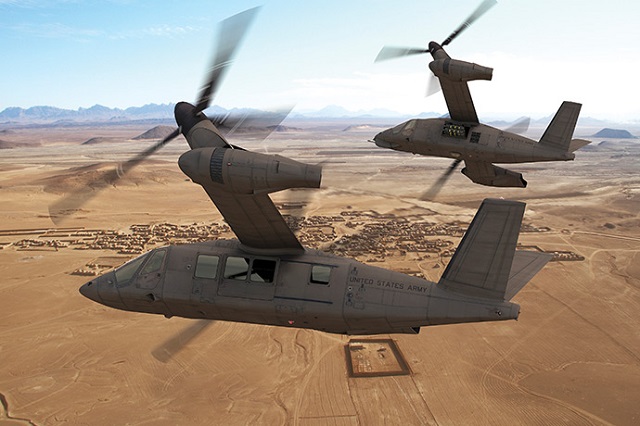The US Army has moved forward with an ambitious project to introduce a next-generation family of rotorcraft designs with funding sought for Future Vertical Lift (FVL) in its fiscal year 2017 budget submission.
Future Vertical Lift-Medium is listed among 15 other “new start” projects in the budget submission sent to Congress on 9 February.
The proposed high-speed rotorcraft initiative has already inspired a competitive fly-off between the coaxial-pusher Sikorsky-Boeing SB-1 Defiant and Bell Helicopter V-280 Valor tiltrotor. But the budget submission market the first time FVL-Medium received seed funding to create a programme office at the army's aviation headquarters in Fort Rucker, Alabama.

Boeing/Sikorsky
Boeing executives have welcomed the news, saying it allows the army to formulate an actual procurement plan and begin an analysis of alternatives (AOA). A so-called materiel decision document (MDD) will be considered and potentially signed by the US under-secretary of defence for acquisition sometime around October, giving life to what could become second largest joint procurement underneath the Lockheed Martin F-35 Lightning II.
“Certainly from industry’s perspective, it’s a good step,” says Patrick Donnelly, director of Boeing future vertical lift. “Up until now, industry has been investing heavily and the fact they’re establishing a budget line is giving some excitement and relief to industry that this plan is going forward. There’s still a long way to go before it becomes a production programme, but this is certainly a very promising first step.”
If approved by Congress, FVL could initially produce mid-weight replacements for the long-serving Sikorsky UH-60 Black Hawk and Boeing AH-64 Apache types. It might also spinoff a Bell OH-58 Kiowa Warrior armed aerial scout follow-on or heavy-lift Boeing CH-47 Chinook replacement.
“There are now five FVL mission sets,” says Donnelly. “We’ll learn which mission set they intend on developing.”

Bell Helicopter
Sikorsky and Boeing are pursuing their SB-1 Defiant compound coaxial helicopter, based on Sikorsky X2 and S-97 Raider technology, as a precursor for FVL under the army’s Joint MultiRole (JMR) technology demonstration. Bell, meanwhile, is pressing forward with its third-generation tiltrotor, which was also selected for the demonstration.
Both sides aim to achieve first flight in the third quarter of 2017.
“[FVL] is going to be one of the largest programmes we undertake [in the Office of the Secretary of Defence] minus the F-35 when you talk about the sheer number of aircraft we’re going to be replacing,” US army aviation centre of excellence commander Maj Gen Michael Lundy said at a conference in January.
“It’s going to continue to get a lot of visibility and right now the support’s pretty good. We have looked at our future investment strategies and FVL is affordable. As long as the budget doesn’t get any worse.”
Source: FlightGlobal.com



















